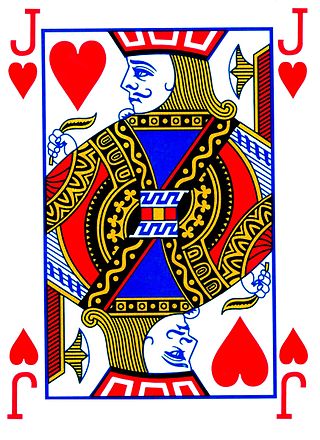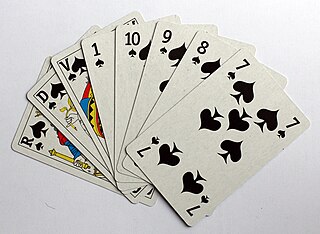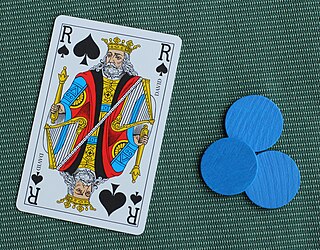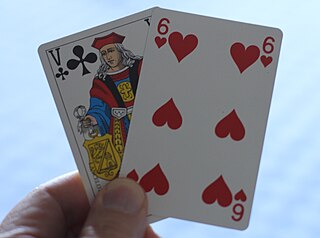
Games of patience, or (card) solitaires as they are usually called in North America, have their own 'language' of specialised terms such as "building down", "packing", "foundations", "talon" and "tableau". Once learnt they are helpful in describing, succinctly and accurately, how the games are played. Patience games are usually for a single player, although a small number have been designed for two and, in rare cases, three or even four players. They are games of skill or chance or a combination of the two. There are three classes of patience grouped by object.

Cassino, sometimes spelt Casino, is an English card game for two to four players using a standard, 52-card, French-suited pack. It is the only fishing game to have penetrated the English-speaking world. It is similar to the later Italian game of Scopa and is often said, without substantiation, to be of Italian origin. Cassino is still played today in Madeira, probably due to English influence.

Bouillotte is an 18th-century French gambling card game of the Revolution based on Brelan, very popular during the 19th century in France and again for some years from 1830. It was also popular in America. The game is regarded as one of the games that influenced the open-card stud variation in poker. The rules continue to be printed in French gaming compendia.
Red Nines is a simple card game of the Stops family for four or more players. It is largely a game of luck, and is suitable for players of any age. Games with more than four players are best when played without hesitation. It has a modern variant called Pink Nines.

Reversis, or more rarely Réversi, is a very old trick-taking card game in the Hearts family. Its origin is uncertain, but it may have emerged in Italy before spreading to Spain and France. It is considered one of the two probable ancestors of Hearts, Black Lady and Black Maria, the other being Coquimbert or Coquinbert. It was very popular with the French aristocracy in the 17th and 18th centuries, and much played elsewhere, except in Britain. Initially quite simple, the game eventually developed more complex mechanics such as vast quantities of counters and a system of pools and side-payments. Its name may have possibly come from the reverse order and construction of the game itself, or even from its exceptional slam which, like "shooting the moon" in Black Lady, reverses the entire aim of the game.

The following is a glossary of terms used in card games. Besides the terms listed here, there are thousands of common and uncommon slang terms. Terms in this glossary should not be game-specific, but apply to a wide range of card games played with non-proprietary packs. It should not include terms solely related to casino or banking games. For glossaries that relate primarily to one game or family of similar games, see Game-specific glossaries.

Tippen, also known as Dreiblatt, Dreikart, Drei Karten, Dreekort, Kleinpréférence or Labet, is an historical German 3-card, plain-trick game which was popular as a gambling game for three or more players. The Danish version of the game was known as Trekort and more elaborate Swedish variants include Knack and Köpknack. It appears to be related to the English game of Three-Card Loo. It was banned as a gambling game in some places.

Zwickern or Zwicker, is a German fishing card game for two to eight players played in Schleswig-Holstein in North Germany. It is an old game whose rules first appeared in 1930. It has been described as "a simpler and jollier version of Cassino", which is "exciting and entertaining" and easy to learn. German author, Hans Fallada, who learned it in while in gaol at Neumünster, called it "a rather cunning farmer's game from Holstein." The feature that makes it unique among fishing games is its use of up to 6 Jokers.
Lampeln or Lampln is an old Bavarian and Austrian plain-trick card game that is still played in a few places today. It is one of the Rams group of card games characterised by allowing players to drop out of the current game if they think they will be unable to win any tricks or a minimum number of tricks.

Mouche, also known as Lanterlu, is an old, French, trick-taking card game for two to six players which has elements, such as bluffing, reminiscent of the much later game of poker. It is a member of the Rams family of games and, although it is a gambling game, often played for small stakes, it is also suitable as a party game or as a family game with children from the age of 12 upwards. It is named after the mouche, a term that variously refers to its winning hand, the basic stake and the penalty for failing to take any tricks. Although also called Bête, it should not be confused with the older game of that name from which it came and which, in turn, was a derivative of Triomphe.

Bête, la Bête, Beste or la Beste, originally known as Homme or l'Homme, was an old, French, trick-taking card game, usually for three to five players. It was a derivative of Triomphe created by introducing the concept of bidding. Its earlier name gives away its descent from the 16th-century Spanish game of Ombre. It is the "earliest recorded multi-player version of Triomphe".

The game of Nain Jaune or Yellow Dwarf, also formerly called Lindor, is an "attractive and unique traditional French card game" using a board comprising five compartments or boxes. It is a reasoned game of chance because it combines the hazards of card distribution with the strategy of building suits. Nain Jaune, which is considered a classic French game, is named after the seven of diamonds, which is depicted as a yellow dwarf in the centre of the game board.

Skwitz was a 19th-century Austrian card game of the fishing type for 2 to 8 players that was said to be of English origin. It may be a descendant of Cassino which it resembles.

Coucou ("Cuckoo") is an historical French card game that uses a pack of 32 or 52 cards and is played by five to twenty players. It is unusual for being played with only a single card in hand. As a shedding game, there is only one winner who may claim the stakes, if there are any. The game has also been called As Qui Court or Hère.

Culbas or Cul-bas is an historical French card game of the fishing type for three to eight players that dates to at least the 17th century. It is described as being "very old" and having "a great simplicity in which chance plays the biggest role."
Comet is a very old, French card game of the stops family for 2 to 5 players that is still played today. It was originally called manille, but acquired a new name on the appearance of Halley's comet in 1682. It is not related to the modern trick-taking game also called manille. The American game of commit is an evolution of comet.

Tontine is an historical French gambling game for five to twelve players using playing cards. It is a social game of pure chance in which the chips (jetons) circulate between the players and the pool until one player wins all the chips in play.

Hoc Mazarin, also just Hoc, is an historical French gambling game of the Stops family for two or three players. The game was popular at the court of Versailles in the 17th century and was named after Cardinal Mazarin, chief minister to the King of France.

Emprunt is an historical French card game of the Hoc family for three to six players that dates to at least the early 18th century.

Ferme ("Farm") is an historical French gambling game of the banking type for ten to twelve players that dates to the mid-17th century. It was described then as being "fun and recreational".

















